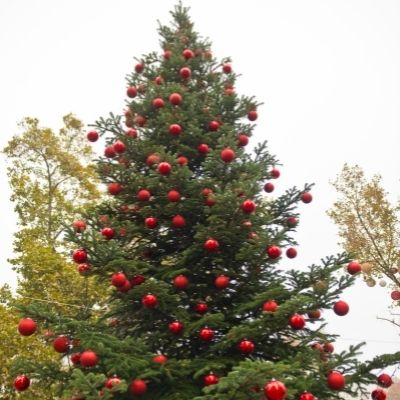
Jill Duffield, the author of Advent in Plain Sight, wrote her devotional book with the purpose of discerning the divine possibilities in what first appears to be commonplace. In her writings, she points to some everyday objects that have lessons to teach us about the coming of the incarnate Lord as well as his glorious return.
This week’s object is the “tree”. In this season of Advent, the weeks preceding our celebration of the Nativity; the tree, at least the Christmas tree, is rather ubiquitous. Be it pine or fir or spruce or any other kind of evergreen, we find them in Christmas tree lots all over town as soon as the Thanksgiving feast is over; we see trees decorated on lawns and in windows; stores and restaurants and a myriad of other public places feature trees covered with lights and ornaments, garlands and stars and a host of other adornments.
The history of the Christmas tree goes back to the symbolic use of evergreens in ancient Egypt and Rome. Eventually the Christian Church adapted some of the pagan customs to their worship of God, including the winter solstice celebration and its accompanying greenery. In fact, by the early Middle Ages, the legend had grown that when Christ was born in the dead of winter, every tree throughout the world miraculously shook off its ice and snow and produced new shoots of green. At the same time, Christian missionaries preaching to Germanic and Slavic peoples were taking a more lenient approach to cultural practices—such as evergreen trees. These missionaries believed that the Incarnation proclaimed Christ’s lordship over those natural symbols that had previously been used for the worship of pagan gods. Not only individual human beings, but cultures, symbols, and traditions could be converted.
Of course, this did not mean that the worship of pagan gods themselves was tolerated. According to one legend, the eighth-century missionary Boniface, after cutting down an oak tree sacred to the pagan god Thor (and used for human sacrifice), pointed to a nearby fir tree instead as a symbol of the love and mercy of God. Centuries later, it is thought that Germany started the Christmas tree tradition as we now know it in the 16th century when devout Christians brought decorated trees into their homes.
But trees, whether evergreens decorated with ornamentation or the bare branches of the oak, maple, and fruit trees this time of year, have, since the creation of the world, pointed to the goodness of God. “The Lord God made to grow every tree that is pleasant to the sight and good for food”, says the author of the second creation story. As Jill Duffield remarks, “Divine provisions move well beyond utilitarian, and commence in beauty. Walking through the woods or a city park, even driving down the street or the Interstate, the diversity and glory of God’s work cannot be missed if one is open to looking up and out.”
She continues, “seeing the glory, tenacity, longevity, the variety of all the trees that surround me reveals God’s goodness, all the time, if I am awake enough to pay attention to them…God’s good creation provides and sustains life, abundant life, not mere survival. Trees clean the air and water; they provide shade and provide fruit, they even mark the seasons, and are pleasant to the sight. They dot the landscapes around us and remind us that God is good, all the time; and all the time, God is good. And they tell us that God desires goodness for us. Not just for sustenance, but to simply enjoy their beauty.
The trees also remind us of the salvation story, part of our message of Advent. One of my favorite parts of this season, especially as a teacher, is the enjoyment of a great story and there are so many written for this time of year. I’m going to attempt to share one of my favorite children’s stories with you (for aren’t we all at least a little childlike at Christmas?). I am attempting to use wonder of technology (hopefully, if it works, and we make it through without commercials); otherwise, I’ll just read it to you. It is entitled the “Tale of Three Trees”
Let us pray:
God, you are good, all the time. Your goodness resounds through creation and through every creature. You gift us with beauty so diverse and persistent that were we to notice all of it, we would be utterly overwhelmed by your life-affirming power. As we go about our day, grant us eyes to see the trees of life that surround us, giving thanks for their ability to provide food, shelter for animals, air for us to breathe, leaves and flowers that are breathtaking pleasant to our sight. All the time, you, God are good. Help us to recognize your goodness as well as your saving work and make it visible to others. Amen.
